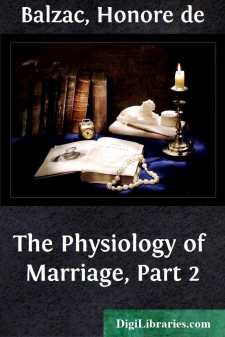Categories
- Antiques & Collectibles 13
- Architecture 36
- Art 48
- Bibles 22
- Biography & Autobiography 813
- Body, Mind & Spirit 141
- Business & Economics 28
- Children's Books 12
- Children's Fiction 9
- Computers 4
- Cooking 94
- Crafts & Hobbies 4
- Drama 346
- Education 46
- Family & Relationships 57
- Fiction 11826
- Games 19
- Gardening 17
- Health & Fitness 34
- History 1377
- House & Home 1
- Humor 147
- Juvenile Fiction 1873
- Juvenile Nonfiction 202
- Language Arts & Disciplines 88
- Law 16
- Literary Collections 686
- Literary Criticism 179
- Mathematics 13
- Medical 41
- Music 40
- Nature 179
- Non-Classifiable 1768
- Performing Arts 7
- Periodicals 1453
- Philosophy 64
- Photography 2
- Poetry 896
- Political Science 203
- Psychology 42
- Reference 154
- Religion 513
- Science 126
- Self-Help 83
- Social Science 81
- Sports & Recreation 34
- Study Aids 3
- Technology & Engineering 59
- Transportation 23
- Travel 463
- True Crime 29
Albert Savarus
by: Honore de Balzac
Categories:
Description:
Excerpt
ALBERT SAVARUS
One of the few drawing-rooms where, under the Restoration, the Archbishop of Besancon was sometimes to be seen, was that of the Baronne de Watteville, to whom he was particularly attached on account of her religious sentiments.
A word as to this lady, the most important lady of Besancon.
Monsieur de Watteville, a descendant of the famous Watteville, the most successful and illustrious of murderers and renegades—his extraordinary adventures are too much a part of history to be related here—this nineteenth century Monsieur de Watteville was as gentle and peaceable as his ancestor of the Grand Siecle had been passionate and turbulent. After living in the Comte (La Franche Comte) like a wood-louse in the crack of a wainscot, he had married the heiress of the celebrated house of Rupt. Mademoiselle de Rupt brought twenty thousand francs a year in the funds to add to the ten thousand francs a year in real estate of the Baron de Watteville. The Swiss gentleman's coat-of-arms (the Wattevilles are Swiss) was then borne as an escutcheon of pretence on the old shield of the Rupts. The marriage, arranged in 1802, was solemnized in 1815 after the second Restoration. Within three years of the birth of a daughter all Madame de Watteville's grandparents were dead, and their estates wound up. Monsieur de Watteville's house was then sold, and they settled in the Rue de la Prefecture in the fine old mansion of the Rupts, with an immense garden stretching to the Rue du Perron. Madame de Watteville, devout as a girl, became even more so after her marriage. She is one of the queens of the saintly brotherhood which gives the upper circles of Besancon a solemn air and prudish manners in harmony with the character of the town.
Monsieur le Baron de Watteville, a dry, lean man devoid of intelligence, looked worn out without any one knowing whereby, for he enjoyed the profoundest ignorance; but as his wife was a red-haired woman, and of a stern nature that became proverbial (we still say "as sharp as Madame de Watteville"), some wits of the legal profession declared that he had been worn against that rock—Rupt is obviously derived from rupes. Scientific students of social phenomena will not fail to have observed that Rosalie was the only offspring of the union between the Wattevilles and the Rupts.
Monsieur de Watteville spent his existence in a handsome workshop with a lathe; he was a turner! As subsidiary to this pursuit, he took up a fancy for making collections. Philosophical doctors, devoted to the study of madness, regard this tendency towards collecting as a first degree of mental aberration when it is set on small things. The Baron de Watteville treasured shells and geological fragments of the neighborhood of Besancon. Some contradictory folk, especially women, would say of Monsieur de Watteville, "He has a noble soul! He perceived from the first days of his married life that he would never be his wife's master, so he threw himself into a mechanical occupation and good living."
The house of the Rupts was not devoid of a certain magnificence worthy of Louis XIV., and bore traces of the nobility of the two families who had mingled in 1815....












